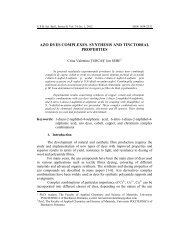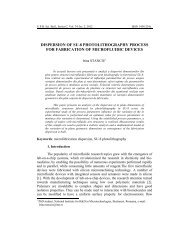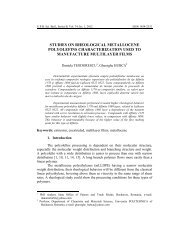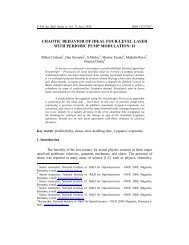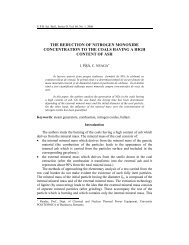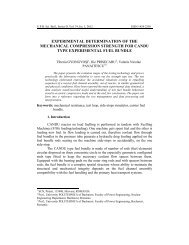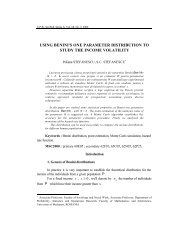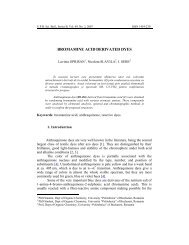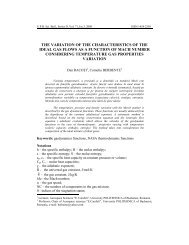U - Scientific Bulletin
U - Scientific Bulletin
U - Scientific Bulletin
Create successful ePaper yourself
Turn your PDF publications into a flip-book with our unique Google optimized e-Paper software.
148 Christian Russu<br />
Φi,<br />
j ⋅ hi,<br />
j ⋅ Δx<br />
p j + − p j Φi,<br />
j ⋅ hi,<br />
j ⋅ Δx<br />
p j − − p j<br />
q j + =<br />
⋅<br />
q j − =<br />
⋅<br />
η Δz<br />
η Δz<br />
(4)<br />
Φi,<br />
j ⋅ hi,<br />
j ⋅ Δz<br />
pi+<br />
− p<br />
Φ h z<br />
i<br />
i,<br />
j ⋅ i,<br />
j ⋅ Δ pi−<br />
− pi<br />
qi+<br />
=<br />
⋅<br />
qi−<br />
=<br />
⋅<br />
η Δx<br />
η Δx<br />
The right side member of eq. 1 defines the source term for the element.<br />
Generally speaking, this is the quantity of the fluid that enters or exits the cell<br />
through other ways than the neighboring elements – in our case as result of<br />
dislocation effect. The definition of this flow depends on the shape of the slider.<br />
For Rayleigh step, the value is 0, except for the nodes found on the line<br />
overlapped with the step (corresponding to the j=k line). For these nodes, we<br />
have:<br />
q in = Δx<br />
⋅ε 0 ⋅ ( h0<br />
− hmin<br />
) ⋅U<br />
(5)<br />
For convergent surfaces model, we have the same value for each cell,<br />
resulting from the constant slope of the slider:<br />
h h<br />
q x U 0 − min<br />
in = Δ ⋅<br />
(6)<br />
n<br />
For the spherical slider case, the value of the inside flow depends on the<br />
position of the element:<br />
Δx<br />
⋅ Δy<br />
⋅U<br />
⋅ ( h h )<br />
q<br />
in<br />
=<br />
i− 1,<br />
j<br />
−<br />
i,<br />
j<br />
(7)<br />
where local thickness of the porous layer is calculated using the first 2 terms of<br />
the Taylor series and thus approximating sphere with a paraboloid.<br />
2<br />
2<br />
2<br />
r<br />
( )<br />
( x − B / 2) + ( y − L / 2)<br />
h x,<br />
y = h(<br />
r)<br />
= ha<br />
+ = ha<br />
+<br />
(8)<br />
d<br />
d<br />
Boundary conditions are imposed by attributing zero values for pressures<br />
in the nodes located at the edge of the geometrical contact surface. Additionally,<br />
for the spherical slider for the nodes situated in the divergent zone of the contact,<br />
if the calculated pressure is negative, the 0 value is attributed automatically during<br />
each iterative cycle.<br />
The problem was solved using the Gauss-Seidel iterative method with the<br />
control on average pressure between two successive cycles. The end iteration<br />
condition was that relative difference between two iterations is smaller than 10 -6 .<br />
The program was written in Pascal and run on a Pentium 4 class processor. The<br />
total solving time for one case varied between 30 and 170 seconds.<br />
3. Results<br />
For a qualitative assessment of the influence of the width/length ratio of<br />
the slider, pressure distributions are presented for Rayleigh step and convergent<br />
surfaces cases.



